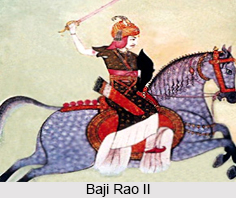 Baji Rao II, the last Peshwa of the Maratha Confederacy was also famous as Palputta Bajirao. He governed the Maratha Empire from 1796 to 1818. His ruling period was marked by confrontations with the British. Baji Rao was the son of Peshwa Raghunathrao and Anandibai. Baji Rao II died in 1851 at Bithur.
Baji Rao II, the last Peshwa of the Maratha Confederacy was also famous as Palputta Bajirao. He governed the Maratha Empire from 1796 to 1818. His ruling period was marked by confrontations with the British. Baji Rao was the son of Peshwa Raghunathrao and Anandibai. Baji Rao II died in 1851 at Bithur.
Early Life of Baji Rao II
Baji Rao was the son of the former Peshwa Raghunathrao and his wife Anandibai. He was born in 1775, when both his parents were imprisoned by the then Peshwa`s cabinet. Until the age of 19 years, he along with his brothers were kept in confinement and denied even basic rights of education. Baji Rao II had to carry the unfortunate legacy of his parents who, despite being from the same Brahmin family, were suspected of being involved in the murder of the young fifth Peshwa Narayanrao in 1774. As such, being the son of suspected murderers, he was looked down upon by his ministers, nobility and even by his subjects. His every action was viewed with prejudice and it is said that though regarded as a good administrator and builder of modern-day Pune, he was often labeled as incapable and a coward Peshwa.
Treaty of Bassein between Baji Rao II and British
In 1800, after the demise of Phadnavis, the Maratha leaders Yashwantrao Holkar of Indore and Daulat Rao Sindhia of Gwalior contested for control of the empire and their rivalry made its way to Pune, seat of the Peshwa. The successes ultimately came to the Holkar. In September 1802, Baji Rao II fled west to Bombay to seek the help of the British and he concluded the Treaty of Bassein in December 1802. In this treaty, the British agreed to restore Baji Rao II in return for the Marathas allowing British troops in Maratha territory and paying for their maintenance, and acceptance of a British political agent (Resident) at Pune. The Second Anglo-Maratha War of 1803-1805 took place due to the protestation of Holkar and Sindhia of the British imposition on Maratha affairs. The British triumphed in the war and the Marathas had to accept the losses of territory.
Battle of Khadki between Baji Rao II and British
The third Maratha War of 1817-1818 was initiated due to the raids of the Pindaris (the irregular horsemen and the residents of the Maratha territories) into British territory and this war ended with the defeat of the Scindhias and other Maratha feudatories. The British Resident at Pune maintained and paid by Baji Rao II for his `protection` attacked Baji Rao`s personal guard on the day of Diwali on November 5, 1817. Baji Rao II ran away and a war was ensued between his forces and the British, which was referred to as Battle of Khadki. Though he ran away, the British chased him and after running for five months from one fort to another, Baji Rao II surrendered to Sir John Malcolm.



















